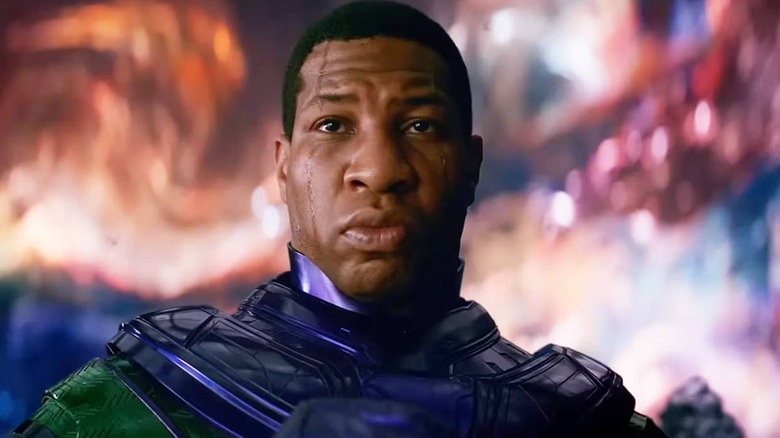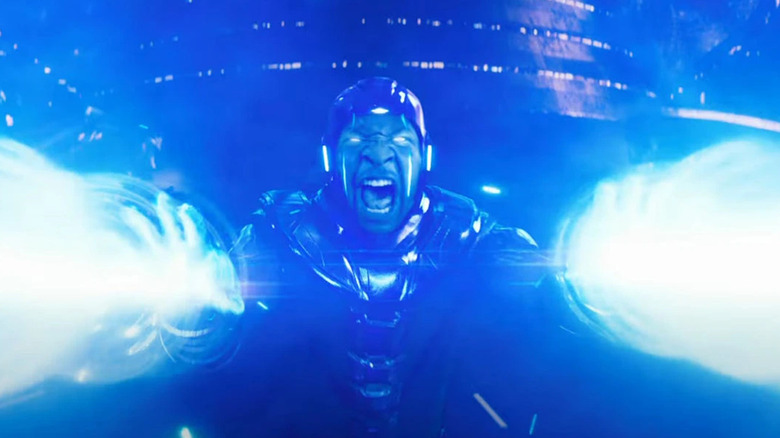Ant-Man 3: Kang's Quantum Realm Time Ship Was Even Weirder In Marvel Comic Books
The following article contains spoilers for "Ant-Man and the Wasp: Quantumania."
The "Ant-Man" movies have generally served as palate cleansers for big events in the Marvel Cinematic Universe. But with the pint-sized hero's latest outing in "Ant-Man and the Wasp: Quantumania," his movie finally sets the stage for something bigger to happen in this franchise. Most significantly, it introduces general audiences to Kang the Conqueror (Jonathan Majors). A variant of Kang showed up before in "Loki," but this version is far more intimidating, as evidenced by him beating the snot out of Scott Lang (Paul Rudd) in the film's trailers.
But he's more than just a one-and-done villain. He sets up grander machinations to happen, which will inevitably lead to "Avengers: The Kang Dynasty." As we learn in "Quantumania," Kang is a genocidal maniac who has destroyed entire worlds and timelines. He travels across the multiverse courtesy of his fancy time chair, but when he first gets exiled to the Quantum Realm, it's broken. He then relies on assistance from Janet van Dyne (Michelle Pfeiffer) to fix it, but after learning what he's done, Janet destroys the engine all over again.
In "Quantumania," the time chair effectively serves as Kang's MacGuffin. He just needs it to work so that he can get out of the Quantum Realm and wreak havoc once again. It's also a source of his power, and when he initially powers it up with Janet's help, it gives him back his suit and technology to be a worthy adversary in battle. But there's a lot more the movies could do with the time chair if they draw from Marvel Comics.
The Time Chair is the source of many of Kang's powers
The Time Chair we see in "Quantumania" is similar to the version in the comics for the most part. It's the source of Kang's time-traveling abilities, allowing him to travel across the multiverse to any period of time he wants. But its powers go far beyond just working for Kang. In the comics, he's used it to transport other people across timelines, too. A noteworthy example of this is a battle against the Avengers, where he transports them to a universe where Earth has been destroyed. He also uses the Time Chair to spy on his enemies, scouting out their strengths and weaknesses so that when it comes time to fight them, he knows precisely what they're capable of.
The Chair is also a source of various powers. For instance, it can be used to generate a forcefield that not even the most powerful attacks can get through. And each variant of Kang has their own version of the Time Chair. Rama-Tut, who could be seen in the first post-credits scene, has a Time Chair in the shape of an Egyptian Sphinx. That means that even though we see the demise of The Conqueror in "Quantumania," there are plenty more Kangs with Time Chairs out there to keep the comic book tradition alive.
Naturally, the MCU will likely put its own spin on the Time Chair and how it connects with other powerful devices we've already seen. The 10 Rings in "Shang-Chi and the Legend of the Ten Rings" were apparently sending a beacon to some unknown location, which means they may have something to do with Kang. There's also Kamala Khan's bangle, which could be a source of multiversal powers. Soon enough, the MCU Time Chair could become even stranger than the comic book one.

